How to connect wires without soldering: the best methods and their features + installation recommendations
A home electrical network is a complex system of electrical installations and devices connected by electrical conductors. Wires are connected in electrical panels, junction boxes and device housings.
Let's look at how to connect wires without soldering using special clamps and terminals so that the switching is as reliable as possible and meets safety requirements. For this purpose, we provide 4 detailed instructions with the best ways to connect electrical wires.
We will also supplement our material with useful installation tips from experienced electrical installation specialists.
The content of the article:
Briefly about possible switching options
Electricians use various methods of connecting conductors - from the simplest insulated twisting to crimping with special sleeves.
Some procedures require additional supplies and special tools, while others are performed manually.
The question of choosing the most reliable connection methods became relevant when the load on the home network increased - many powerful devices appeared, and accordingly, the requirements for the use of conductors and electrical installations became more stringent.
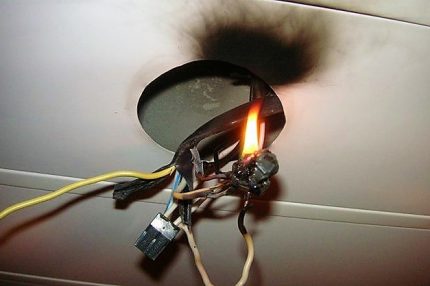
Factors influencing the choice of method:
- total cross-section of conductors;
- type and method of cable insulation;
- the material from which the wires are made;
- purpose of the switching node;
- external connection conditions;
- degree of mobility of the connection, etc.
The installer on site determines how he will make the switching, taking into account the listed factors. Much depends on his skills in using a special tool (soldering iron, welding machine, crimping pliers) and materials that are at hand.
However, professionals always have an installation kit with them and use methods recommended by GOST and PUE standards.
Today you can encounter a variety of wire connection options:
According to PUE 2.1.21, simple twisting should in principle not be used for switching. Only welding, soldering, crimping and various types of clamping devices.
To perform soldering or welding, special equipment is not always at hand, especially if the work is performed by an amateur. Therefore, it is advisable to consider methods that are both reliable and affordable.
Safe and effective types of connections
Let's consider 4 options for connecting conductors, suitable for home installation: spring terminal blocks, terminal blocks, PPE caps and crimping with sleeves.
To perform the work, you will need consumables - terminals, clamps, sleeves, selected depending on the type and cross-section of the conductors. We recommend purchasing products only from trusted manufacturers, and not cheap Chinese substitutes.
Method #1 - switching with WAGO terminal blocks
The main advantage of terminal switching is 100% connection reliability. Thanks to the company's developments WAGO screwless connections have received the status of an international standard.
Now other manufacturers are also producing spring clamps. They are used in high-speed cars, airplanes, moving chains - that is, where special responsibility is required.
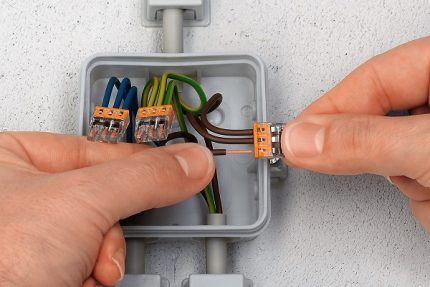
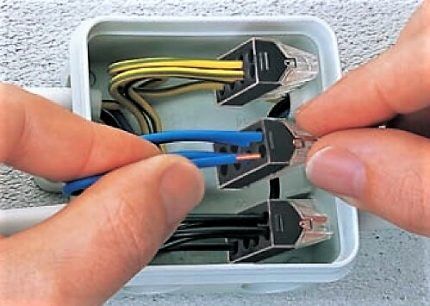
To install the terminal block, you do not need any special preparation. Experienced installers who value quality have also long used only self-clamping terminals.
We offer step-by-step instructions for connecting 2 conductors using a 222 series clamp, representatives of which are successfully used to connect branches of various types of wires:
After correct execution of the actions, spontaneous opening of the terminal is impossible. The advantage of such a connection is the possibility of disconnection. To open the conductors, you must first press the moving mechanism and then remove the corresponding conductor.
Advantages of terminal connection:
- connection of single- and multi-core conductors made of copper or aluminum, as well as mixed connections;
- high quality connection;
- the conductors are not damaged during installation;
- the design provides for reading the circuit parameters without disconnecting;
- neatness and order in places of work - distribution boxes, switchboards, electrical installation devices.
This method saves time - it only takes a few seconds. However, it requires caution. If the ends are not inserted all the way, overheating may occur and the terminal block body will melt.
The main disadvantage is the high cost, especially of branded products. For example, a set of 20 Vago three-wire universal terminal blocks costs about 500 rubles.
Even more information about Vago terminals in the following video:
Method #2 - Using Terminal Blocks
Inexpensive plastic products have a clamping mechanism with which the conductors are fixed and connected inside the housing. Each single- or multi-core wire is stripped of its insulation, inserted into a separate socket and secured by tightening a screw.

Usage stripper for insulation removal allows even a beginner to cope with this task without much difficulty.
The wires can be wound in two ways - from one side or from both sides, towards each other. This method is often used for wiring in distribution boxes, so manufacturers began to produce distribution boxes with built-in terminals.
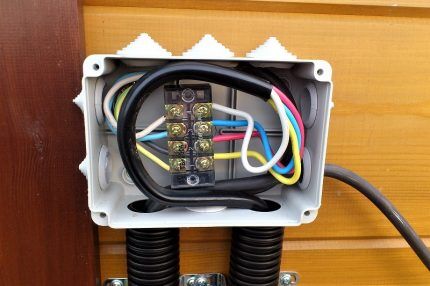
Advantages of connecting with blocks:
- efficiency;
- quick installation;
- aluminum/copper connection;
- high quality.
The main disadvantage is that only 2 reins can be connected with one pair of blocks. Experienced installers do not recommend using the block method to connect stranded or aluminum wires, since a screw connection can destroy more fragile material.
And another minus is a large number of low-quality pads.
To better understand this method of connecting wires, we recommend looking at why terminal boxes are good or bad:
Method #3 - use of PPE caps
Non-flammable plastic is used to make spring clip-caps. The housing material is an insulator, suitable for mechanical and fire protection parameters.
To install the cap, you need to prepare the wires, insert them inside, and then forcefully make twisting movements. To protect the exposed parts of the cores from oxidation, the inside of the cap is treated with paste.
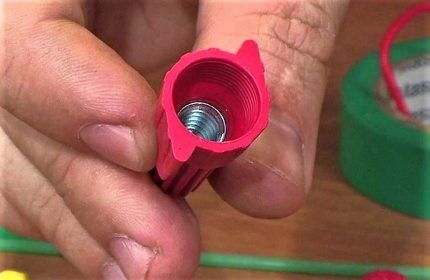
The caps are compact and have a simple design, so they are often used for desoldering. One distribution box contains up to ten products.
A practical example of using PPE for wiring in a distribution box:
After completing the connection work, carefully place the caps in a circle and close the junction box cover. You can unscrew the spring elements at any time and make reconnection or repairs.
Benefits of PPE:
- low cost;
- material – non-flammable polymer;
- high speed and ease of installation;
- variety of colors.
The last point can come in handy when using old, non-color-coded wiring. You can determine the purpose of the cores using caps, selecting them by color. We talked more about color coding of wires In this article.
The main disadvantage is that the connection is considered unreliable. The spring force is not enough to ensure a strong connection, which is why additional twisting is performed.
It is recommended to check the quality of the products before use.
And further - PPE is not intended for switching aluminum/copper wires.
Method #4 - crimping conductors with sleeves
This method is chosen by installers who really care about the quality of the connection.Crimping with a special tool guarantees an increase in the contact area and minimal resistance.
If you cut the crimped sleeve in half, you can see that all the wires have practically merged into one monolith.
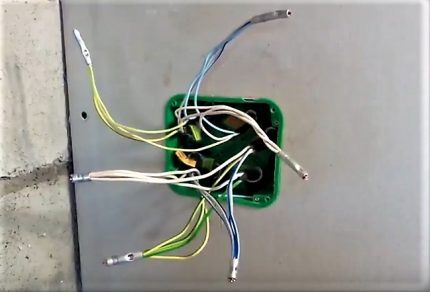
The veins can be wound from one side or from both. In any case, their total cross-section should not be larger than the diameter of the sleeve.
In practice, they often choose a larger sleeve, and the free space inside it is “clogged” with pieces of wiring. The more densely the sleeve is filled, the better the connection.
Step-by-step instructions for crimping:
If there is a shortage of space in the box and compactness comes first, before crimping the sleeve is cut in half and crimped only once. But this should be considered an exception.
This method is considered inexpensive - each sleeve (copper) costs 8-9 rubles, and pliers can be rented.
Advantages of crimping:
- excellent connection quality;
- efficiency;
- high speed.
The disadvantage is that the connection is permanent, and if necessary, you will have to completely replace the switching blocks. If there is a supply of wires left in the box, then the old sleeve is cut off and a new one is installed.
The downside is that without a special tool it will not be possible to perform high-quality crimping.
Tips from experienced installers
There are many controversial issues both in connection methods and in the use of individual mounting products. But a number of rules apply to absolutely all craftsmen who do electrical installations.
For example, Twisting of aluminum conductors with copper is strictly prohibited.. The process of rapid oxidation leads to the destruction of the commutation and the creation of a dangerous point, which can spark or flare up at any time.
A few more important rules:
If the conductor is covered with an oxide film, it must be carefully removed using either contact paste or fine sandpaper. It is better to select the diameters of sleeves, tips, caps according to size.
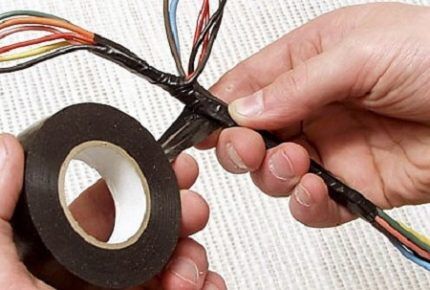
Single conductors in screw terminals are held loosely. Therefore, it is recommended to bend the stripped end in half or make an arbitrary loop out of it.
At the end of the work, be sure to check the reliability of the connections - lightly tug the wires. It happens that the switching is unsuccessful, and the core simply slips out of the terminal block.
If the volume of the distribution box allows, for example, the panels accommodate a lot of wires and devices, then leave the cable with a reserve. Sometimes switching is required and the extra length is useful if the connections are permanent or burnt.
We also have other articles on our website on conductor connectors, methods of connecting wires of different sections, and recommendations for choosing the best connector:
- Methods of connecting electrical wires: types of connections + technical nuances
- Terminals for connecting wires: which terminal blocks are better and how to work with them
- Wire connectors: the best types of connectors + what to look for when choosing a connector
Conclusions and useful video on the topic:
Comparative analysis of various switching methods:
As you can see, when arranging electrical wiring, you can completely do without soldering and welding.
There are enough modern devices on the market to ensure the switching of conductors using safe and efficient technologies. The choice of method depends on personal preferences and financial capabilities..
Are you looking for a safe way to connect electrical wires without soldering, but do you still have questions that we did not address in our article? Feel free to ask your questions to our experts in the comments section.
If you have extensive experience in performing electrical installation work, in particular, connecting conductors without the use of soldering and welding tools, please leave useful recommendations for beginners and additions to our material below under the article.




There are ways to connect wires without soldering, but the main thing is that it is not simple twisting. It is impossible to create a reliable connection through twisting; over time, it will definitely begin to overheat, or even spark. How many ignitions and fires have already occurred and will continue to occur due to disregard for wiring. You need to approach this topic very carefully and responsibly.
I have professional experience in electrical installation work. Based on it, of course, I choose sleeves. You just need to leave the ends of the wire with a margin, that is, about 20 cm. The sleeves are easily crimped with pliers, the main thing is that it is filled. In second place in terms of reliability are clamping blocks. But lighting wiring with many beams and a large number of cores is difficult to make using blocks.
Good afternoon, Vladimir.
Connecting cables and wires with crimp sleeves is a whole science. Having worked in the electric power industry for a long time, I came across a variety of technologies that take into account all sorts of factors regulating the tool used.
I saw manual, mechanical, hydraulic pliers, I saw how explosive crimping works. In the latter case, special dies and punches are used. The crimping part of the pliers, I note, also has an intricate configuration. The only thing I didn’t see was crimping with pliers.This connection will not pass the tests - read the “Rules for the technical operation of consumer electrical installations” section “p3.0.1”.
You can supplement your experience as an electrician with special literature. Among these is “Instructions for connecting insulated cores of wires and cables” under the number “I 1.09-10”.
About wire stocks and other intricacies of their preparation for connection, you can read GOST 23469.3-79 “Cable connecting copper sleeves, secured by crimping.”
Professional electricians have this expression: a hot joint is always cold (note: quality), and a cold joint is always hot.
The most reliable connection method is welding. The sleeves are in second place, everything else is for open access only.